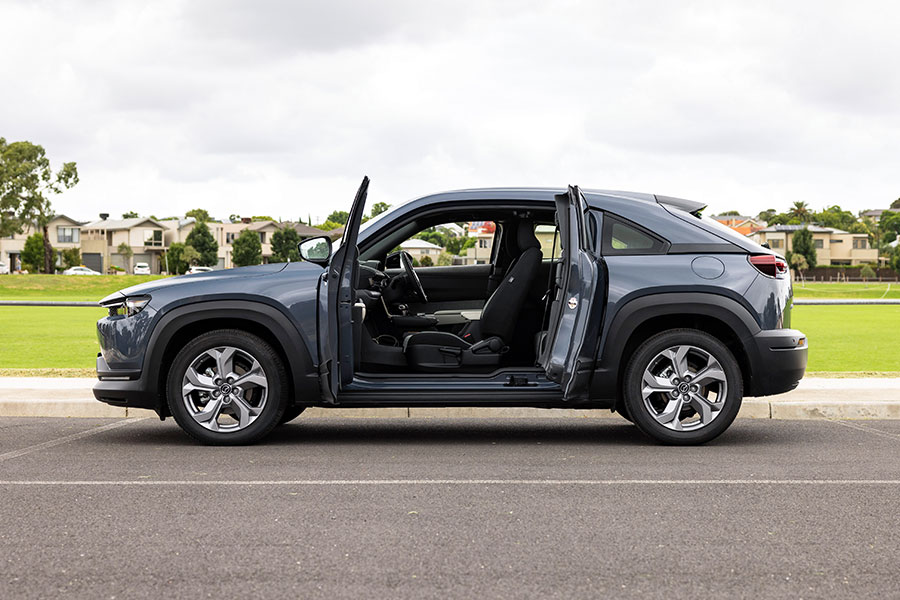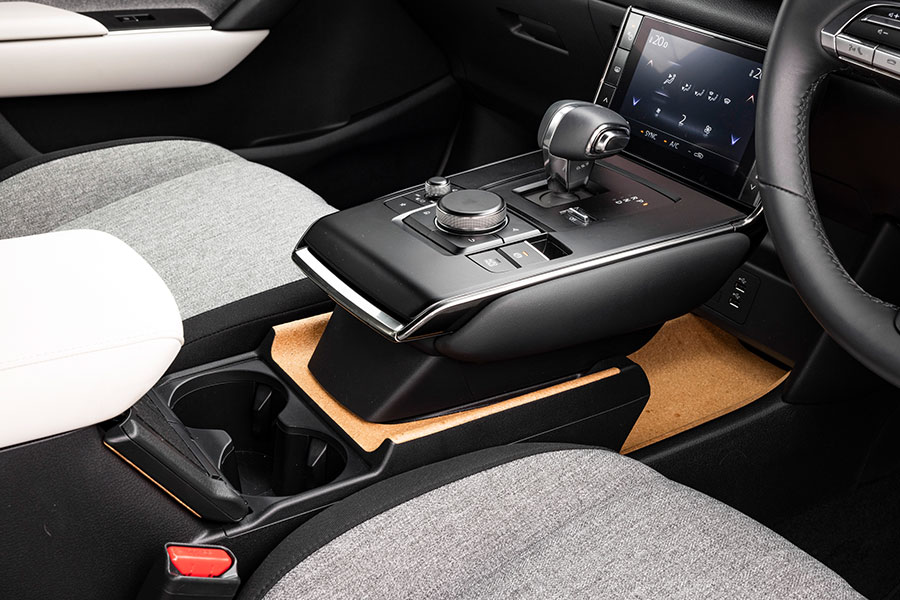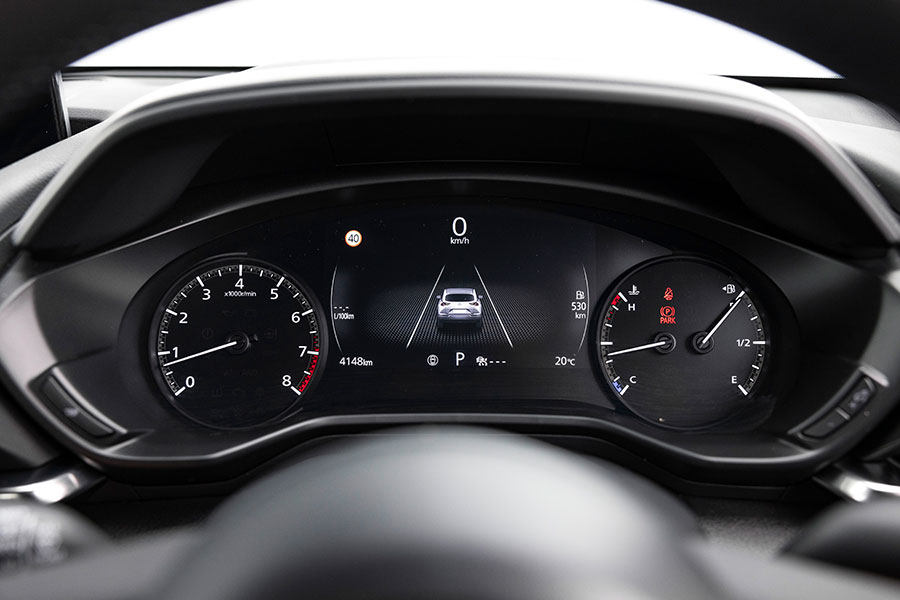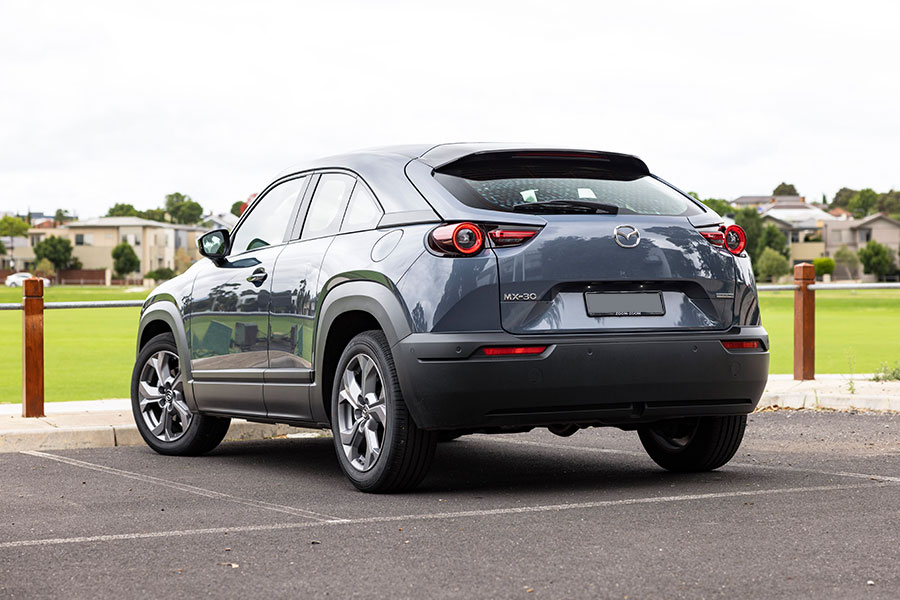Whether you’re ready to get started or would like to know more, we’re here to help.
By Ken Gratton, carsales.com.au
Mazda likes to do things its own way.
The Japanese brand bravely – and almost singularly – took an alternate path to combustion engine technology when it adopted the Wankel rotary engine in the late 1960s and kept the free-spinning engine alive for almost 40 years when no-one else followed.
And now, as the entire automotive industry is being diverted down the road to an electrified future, Mazda has, once again, veered off track with a solution it believes offers consumers an affordable, and still efficient, shortcut to fully electric cars.
It’s the Mazda MX-30, which is a green-tinted oddball that is part SUV and part small hatch – and yet is actually neither.
So, what is it?
Well, the 2022 Mazda MX-30 sits somewhere between the more conventional city-sized CX-3 (and its swoopier CX-30 sibling) and the family favourite CX-5 and is aimed at urbanites and small families that want something equally practical but a little left of centre.

The MX-30 rekindles Mazda’s on-again, off-again reputation for innovation, reviving some styling elements from the 1990s 323 Astina hatch as well as the backwards-opening ‘freestyle’ rear doors last seen in the RX-8 sports coupe.
It first arrived in early 2021 with a (very) mild hybrid petrol engine that makes Subaru’s basic petrol-electric powertrain seem positively cutting edge and was joined later in the year by a fully battery-powered version that became the brand’s first dedicated electric car.
Down the track, Mazda is likely to expand the range of powertrain options and provide the rotary engine with a new lease on life as an on-board power generator that acts as a range-extender for the MX-30 EV.

Enhancing the eco credentials, the interior features fibres made from recycled plastic bottles for some of the upper the door trim, cork harvested from live trees on the centre console and seat upholstery that is made from approximately 20 per cent recycled thread.
On top of that, there’s some interesting multi-colour exterior paint combinations (that vary from model to model) and you have a compact Mazda that flaunts itself in a manner characteristic of some European small cars.
So, what are we to make of this small, quite distinctive and in some ways beguiling five-door hatchback, err, coupe-style small SUV?
In a range that extends from the base model G20e Evolve we are reviewing here to the full-electric, short range and pricey E35 Astina, the Mazda MX-30 has something of a niche vibe for those who don’t like to be categorised.
You like it mild, or spicy?
The 2022 Mazda MX-30 M Hybrid G20e Evolve (to give it the full name) kick starts the range at $34,190 plus on-road costs (ORCs), which is a couple of grand cheaper than the comparable CX-30 with the same powertrain.
Buyers can choose to step up to the mid-spec Touring model for an additional $2500 or the Astina at $41,190 (plus ORCs), or pay almost double for the flagship, fully electric MX-30 E35 Astina at $65,490 (plus ORCs).
The price of the MX-30 G20e Evolve puts it into direct competition with rivals such as the Subaru XV Hybrid (from $35,490) and Toyota C-HR Hybrid (from $37,665).
But our entry-level test car hardly rates as a poverty pack.
Coming with a swag of airbags – 10 in all – that cover the usual front, side, driver’s knee and window bags as well as side bags for the back-seat passengers and, up front, a centre airbag designed to help prevent contact between passengers in a collision, the MX-30 is at the top of the game.

It is also armed with a comprehensive suite of electronic driver aids including front and rear autonomous emergency braking (AEB), lane keeping assistance, blind spot monitoring with steering assist, driver attention detection, radar cruise control that works across the speed range, rear cross traffic alert with turn-across traffic monitoring, traffic sign recognition and self-dipping LED headlights.
Is it a proper hybrid?
Just as the 2022 Mazda MX-30 is not a proper SUV, it doesn’t really qualify as a conventional hybrid either.
Basically, the petrol engine is the naturally aspirated Mazda 2.0-litre SKYACTIV G20 long-stroke four-cylinder that produces 114kW/200Nm. It’s the same engine used across a broad range of Mazda vehicles, including the CX-3, CX-30, CX-5 and Mazda3 hatch and sedan.
In this case it’s described as a hybrid because regenerative braking charges a small lithium-ion battery that provides bursts of power to an integrated starter-generator that can fire up the engine in stop/start traffic and contribute, according to Mazda, a little extra torque when on the move to occasionally help it along.
Tellingly, it does little for performance, fuel economy or exhaust emissions.
In this context, it’s similar to Subaru’s all-wheel drive but similarly minimalist XV Hybrid, which does employ a small electric motor to enhance the engine’s power and torque, but to little effect.
Not that the Mazda MX-30 M Hybrid is torpid when it comes to the driving experience. The engine sounds willing and revs freely and it cruises along easily. But it does require a liberal stab on the throttle to get away swiftly and judicious use of the six-speed automatic standard steering wheel shift paddles when on the move.
Hybrid economy isn’t part of the picture and, given the specifications, that’s no surprise.
Owners can expect an average consumption of around 8.0L/100km – well below the official 6.4L/100km claim.
Where the MX-30 does make up ground is in its comfy driving position, sharp steering and predictable, dynamic handling that are all helped by a taut-feeling body – even though the freestyle doors preclude the use of a proper B-pillar.
A playful space
If you’re not one of the sheep and like things that are little left of centre, then the Mazda MX-30 might be an appealing proposition.
Within the package there are plenty of things to surprise and delight.

These include the fact that the designers have pushed the wheels as far into each corner as possible, creating a 2655mm wheelbase – which is shared with the Mazda CX-30 – that ensures the cabin is more spacious than its diminutive exterior proportions might suggest.
For example, if you’re 180cm tall and sitting behind an equally lofty front passenger, the MX-30 provides adequate legroom, foot space and headroom, on nicely comfortable seats.
The main downsides, where form has beaten function, are that the multi-paned side glass and solid C-pillar blot out both your side view and the driver’s rearward vision.
And despite its premium leanings, the MX-30 doesn’t offer air vents for the rear seat passengers.
The freestyle rear doors are a novel point of difference. They help give the MX-30 its character but the reality is they aren’t as practical as conventional doors and getting in and out of the back seat can be a task for those who are not particularly agile.
Despite this, the interior is inviting. There’s soft-touch and cloth surfaces throughout and, although the seats are adjusted manually and unheated, all occupants are treated to plenty of comfort and support. And they can be entertained by an eight-speaker audio system with sat-nav and Apple CarPlay/Android Auto connectivity while kept cool by dual-zone climate-control air-conditioning.
The cabin’s ergonomics are typically Mazda and spot on for simplicity. The main screen located atop the dash is controlled by tactile knobs in the centre console while touch-screen functions are limited to the climate-control pad located forward of the shift lever.
One small glitch is that the some of the satin-finish control switches on the steering wheel spokes are unreadable in most lighting conditions.
Seat coverings at Evolve level are not leather, but are instead an attractive, partly recycled cloth while the hopefully durable cork trim around the ‘floating’ centre console is an individualised touch that some will like, and some won’t.
The 311-litre boot, similar in capacity to the donor CX-30 (317 litres) is smaller than the hybrid Subaru XV’s 345 litres and closer to the Toyota C-HR Hybrid’s 318 litres. Like the C-HR and CX-30, the MX-30 gets a space-saver spare tyre where the Subaru makes do with a repair kit.
Casual chic
Even though the 2022 Mazda MX-30 M Hybrid G20e Evolve doesn’t seem to make sense on paper, it does a pretty convincing job in real life.
Dynamically, there’s a nice cohesiveness in the combination of decent engine power and its capable chassis that borrows a thread of DNA from the MX-5.
And the stylists who designed the MX-30’s interior have created a cabin that is comfortable, spacious and thoughtful while also being a little adventurous.
The reality is that Mazda isn’t going to move a bucket load of MX-30s but it does have the potential to secure a niche in a market segment where there’s nothing else quite like it.
How much does the 2022 Mazda MX-30 M Hybrid G20e Evolve cost?
| Price: $34,190 (plus on-road costs) |
Transmission: Six-speed automatic |
| Available: Now |
Fuel: 6.4L/100km (ADR Combined) |
| Engine: 2.0-litre four-cylinder petrol |
CO2: 150g/km (ADR Combined) |
| Output: 114kW/200Nm |
Safety rating: Five-star (ANCAP 2020) |
Disclaimer: Images supplied by carsales.
This article was prepared by an independent author. The information contained in this article represents the views and opinions of the original author, and is based on research carried out by the original author. The appearance of the article on Maxxia's website does not constitute an endorsement of its content by Maxxia in any way. The article has been made available for informational purposes only and should not be taken as advice. While all reasonable care has been taken to ensure that the statements made by the original author in the article are fair and accurate, Maxxia does not guarantee or warrant the accuracy or completeness of this information and will not be liable for, or in connection with, any loss or damage suffered as a result of any inaccuracies, errors or omissions or your reliance on this information. You should independently research and verify information before making any decision in respect of a vehicle.


